
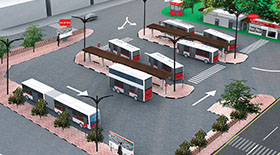 As part of the RTA’s effort to secure an adequate and efficient public transport network that is capable of accommodating the anticipated Expo 2020 ridership along with the projected public transit needs in the future, TrafQuest was appointed to conduct the transport integration studies for a total of 10 RTA Bus Stations across Dubai. At the end of each study, TrafQuest developed and presented 3 TICP options that provided a broad balancing ground for optimum benefit and cost.
As part of the RTA’s effort to secure an adequate and efficient public transport network that is capable of accommodating the anticipated Expo 2020 ridership along with the projected public transit needs in the future, TrafQuest was appointed to conduct the transport integration studies for a total of 10 RTA Bus Stations across Dubai. At the end of each study, TrafQuest developed and presented 3 TICP options that provided a broad balancing ground for optimum benefit and cost.
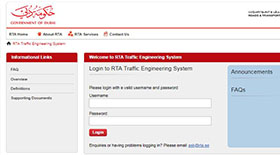 TrafQuest was contracted by RTA to design, build and operate an advanced Traffic Engineering System. The main objective of the system is creating a platform to provide next generation of traffic engineering services for internal and external stakeholders at RTA. TrafQuest is fulfilling this objective by creating an advanced system that:
TrafQuest was contracted by RTA to design, build and operate an advanced Traffic Engineering System. The main objective of the system is creating a platform to provide next generation of traffic engineering services for internal and external stakeholders at RTA. TrafQuest is fulfilling this objective by creating an advanced system that:
 TrafQuest was selected Abu Dhabi Department of Transport (currently DMAT) to provide transportation engineering studies as well as design and supervision services for the Higher Committee on Traffic on an on-call basis. The Services include:
TrafQuest was selected Abu Dhabi Department of Transport (currently DMAT) to provide transportation engineering studies as well as design and supervision services for the Higher Committee on Traffic on an on-call basis. The Services include:
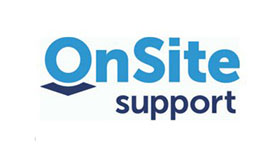 TrafQuest was contracted by the DoT to provide consultancy services for conducting and reviewing transportation studies. As part of this contract, TrafQuest mobilized a team of experienced and capable personnel embedded full time in the DoT offices in Abu Dhabi city and Al Ain. TrafQuest responsibilities under this contract include but are not limited to being able to conduct, review, and/or evaluate different types of studies such as:
TrafQuest was contracted by the DoT to provide consultancy services for conducting and reviewing transportation studies. As part of this contract, TrafQuest mobilized a team of experienced and capable personnel embedded full time in the DoT offices in Abu Dhabi city and Al Ain. TrafQuest responsibilities under this contract include but are not limited to being able to conduct, review, and/or evaluate different types of studies such as:
All of the above services are to be performed by staff members that are solely dedicated for the above contract and available full time on DoT premises.
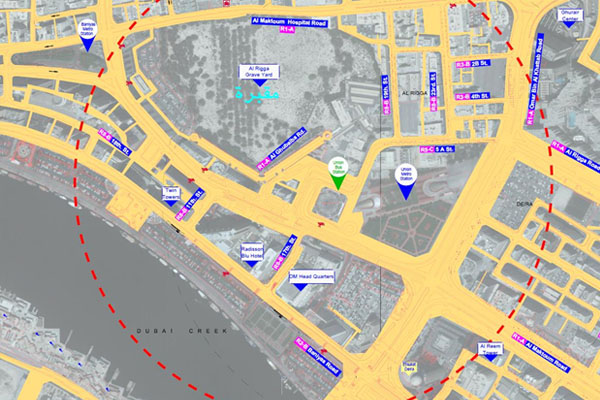
Union Bus Station is located alongside Al Maktoum Road near its intersection with Omar Bin al Khattab Road. The location of this station makes it important to ensure it is well-integrated with the nearby public transport hubs including Union Metro Station, Baniyas Metro Station and Baniyas Marine Station.
The site visit was carried out from two different perspectives: the driver’s perspective and thepassenger/pedestrian’s perspective. The former involves driving throughout the study area toidentify the needed vehicular traffic-related enhancements, whereas the latter involves the simulation of the passengers’ movement between the public transport nodes and key generators and the bus station.
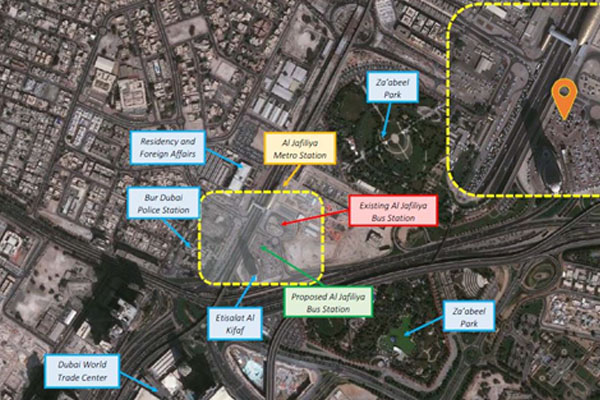
Al Jafiliya Bus Station is located alongside Sheikh Khalifa Bin Zayed Road and is also accessible from Sheikh Zayed Road. The station is located close to some of the major public transport hubs including Al Jafiliya Metro Station and World Trade Center Metro Station. The station is also located close to key generators Etisalat Al Kifaf, Residency and Foreign Affairs and Za’abeel Park.
The improvement measures developed as part of this study will aim primarily to enhancing the pedestrian and cyclist’s mobility within the site to ensure a safe, efficient and convenient access to the surrounding developments and public transport facilities. The guidelines outlined in the Dubai Transport Integration Manual as well as other current RTA manuals will be followed in this study. The impact of the proposed solutions and the developed design on the following will be taken into consideration
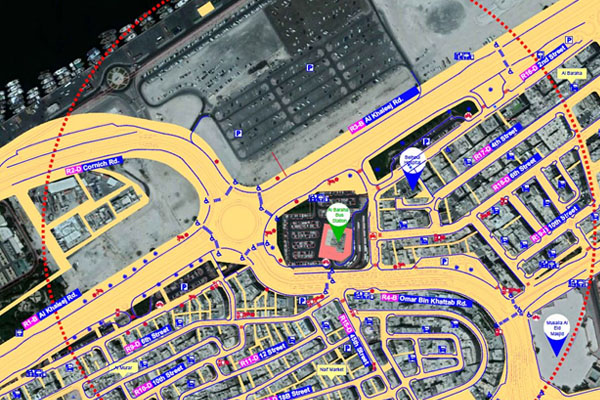
Al Baraha Bus Station is located alongside Al Khaleej road (D92) street, east side of the intersection with Omar Bin al Khattab Road (D88). The location of this station makes it important to ensure it is wellintegrated with the nearby residential & commercial developments and metro stations.
Based on the study area (buffer zone) specified earlier for this station, TrafQuest conducted multiple site visits to evaluate the site from a transport integration standpoint, identify the problems and shortages, investigate the available opportunities to address these problems and identify the design constraints that could inhibit the implementation of the solutions.
The site visit was carried out from two different perspectives: the driver’s perspective and the passenger/pedestrian’s perspective. The former involves driving throughout the study area to identify the needed vehicular traffic?related enhancements, whereas the latter involves the simulation of the passengers’ movement between the public transport nodes and key generators and the bus station.